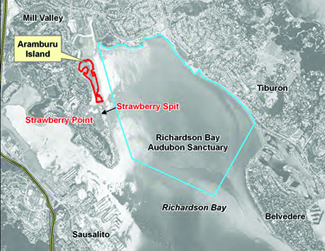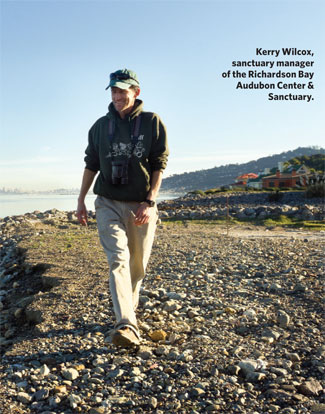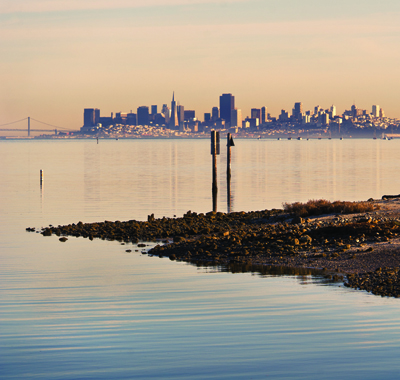FIRST, LET’S GET the pronunciation right: The island’s name is ah – ram – boo – ru. It was named to honor Al Aramburu, a guitar-playing Marin County supervisor during the 1980s who was also on the San Francisco Bay Conservation and Development Commission.
Aramburu Island is located in Richardson Bay, just south of Tiburon Boulevard near the community known as Strawberry. Don’t expect to see the 17-acre atoll as you drive by, however — it is not easily visible from the road. In fact, the only folks who have a view of Aramburu Island are some of the residents of Strawberry.
As islands go, Aramburu is young, and also it’s man-made. Back in the late 1950s, before environmental regulations prohibited such behavior, the developers of Strawberry carved out their lots, graded their roads and simply dumped their excess dirt in Richardson Bay. That’s how Aramburu Island came to be.
Then, years went by. In the early 1980s, more homes were built on a sliver of land that is now rather irreverently called Strawberry Spit. Supervisor Aramburu (who now lives in San Mateo) did not think any homes should be built on the dirt that was dumped in the bay, so he insisted a channel be cut between the homes on Strawberry Spit and the pile of hilltop dirt we now call Aramburu Island. Aramburu’s channel also kept people from walking, many of them with dogs, out on the newly-minted island. At first, Aramburu Island was 34 acres, but years of wind, rain and the tides have eroded the island down to its present size of 17.
 “The erosion of what was once hilltop dirt continues to foul the bay,” says Brooke Langston, executive director of the Richardson Bay Audubon Center & Sanctuary. “We had to find a way to curtail it.” Also, she says, “soil from the top of a hill is vastly different from marine soil, which, thanks to Mother Nature, contains millions of tiny bugs, worms and crustaceans that shorebirds love to feed on.” Making matters worse, nonnative plants — Scotch broom, Monterey pine, acacia and ice plant — have been allowed to flourish on the island. “Migratory birds stay away from those type of plants,” Langston adds.
“The erosion of what was once hilltop dirt continues to foul the bay,” says Brooke Langston, executive director of the Richardson Bay Audubon Center & Sanctuary. “We had to find a way to curtail it.” Also, she says, “soil from the top of a hill is vastly different from marine soil, which, thanks to Mother Nature, contains millions of tiny bugs, worms and crustaceans that shorebirds love to feed on.” Making matters worse, nonnative plants — Scotch broom, Monterey pine, acacia and ice plant — have been allowed to flourish on the island. “Migratory birds stay away from those type of plants,” Langston adds.
The Aramburu Island Enhancement Project — developed in  cooperation between Marin County Parks and Open Space Department and the sanctuary and funded by the California Water Quality Control Board and several other agencies— is well under way. It’s a $4.2 million effort to “provide a super high-quality habitat for shorebirds, migrating birds, even harbor seals,” Langston says. Also included are procedures that will halt the island’s continuing erosion.
cooperation between Marin County Parks and Open Space Department and the sanctuary and funded by the California Water Quality Control Board and several other agencies— is well under way. It’s a $4.2 million effort to “provide a super high-quality habitat for shorebirds, migrating birds, even harbor seals,” Langston says. Also included are procedures that will halt the island’s continuing erosion.
Track back to a cold and gray morning last summer, when a barge came through the fog and landed on Aramburu Island. “On board were an excavator and a tractor grader and their crews began the restoration work,” Langston recalls. “We couldn’t have been more excited.” Over the coming days, much of the nonnative plant material was removed and the southern end of the island was smoothed down to create a gentle shoreline.
“Then a second barge arrived, and we watched like little kids as piles of rocks, sand and crushed oyster shells were unloaded and spread along the newly formed shoreline,” she recounts. “Crews then built retention groins from rocks and huge eucalyptus logs. From here on in, Mother Nature will work her magic.”
Humans, too, will continue to make their mark. Langston says it’s hoped that more marine soil for Aramburu Island will come from bay dredgings required for the 2013 America’s Cup races. “Ideally, it will be donated,” she says. At that point, sprouts of gum plant, pickleweed and other marsh plant life — seeded in black plastic tubes by local high school volunteers — will be poked into the soil of Aramburu Island, and the existing pile of hillside soil will enter a final phase of its makeover and be on its way to becoming a native habitat.
And the source of funds for the $2.5 million restoration? “Most of it comes from the settlement involving the 2007 Cosco Busan tanker oil spill,” says Langston, who is quick to thank the California Regional Water Quality Control Board, the Sewer Agency of Southern Marin, the County of Marin, the Marin Community Foundation and the National Fish and Wildlife Foundation for making the project happen.
“When it is finished, which will be sometime in 2017, there will be a spot on Aramburu Island’s northern tip for kayakers to put in and picnic.” And so the transformation of Aramburu Island will be complete. Or, more accurately, a new life for the island will begin.



